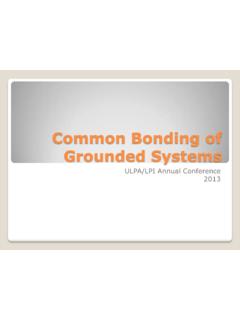Transcription of The Bitcoin Lightning Network
1 The Bitcoin Lightning Network DRAFT Version Poon Thaddeus Dryja The Bitcoin protocol[1] can encompass the global financial transaction volume in all electronic payment systems today, without a single custodial 3rd party holding funds or requiring participants to have any more than a computer on a home broadband connection. A decentralized system is proposed whereby transactions are sent over a Network of micropayment channels ( payment channels or transaction channels) whose transfer of value occurs off-blockchain. If Bitcoin transactions can be signed with a new sighash type which addresses malleability, these transfers may occur between untrusted parties along the transfer route by contracts which are enforceable via broadcast over the Bitcoin blockchain in the event of uncooperative or hostile participants, through a series of decrementing The Bitcoin Blockchain Scalability ProblemThe blockchain as a payment platform, by itself, cannot cover the world s commerce anytime in the near future.
2 If each node in the Bitcoin Network must know about every single transaction that occurs globally, that may create a significant drag on the ability for the Network to encompass all global financial payment Network Visa is believed to do 45,000 peak transactions per second on its Network during holidays, and hundreds of millions average per day. Currently, Bitcoin supports around 7 transactions per second with a 1 megabyte block limit. If we use an average of 300 bytes per Bitcoin transaction and assume unlimited block sizes, an equivalent capacity to peak Visa transaction volume of 45,000/tps would be nearly 8 gigabytes per Bitcoin block, every ten minutes on average.
3 Continuously, that would be over 400 petabytes per year. Clearly, that isn t feasible today. Today s personal computers cannot operate with that kind of bandwidth and storage. If Bitcoin is to replace all electronic payments in thefuture, not just Visa, as currently implemented it can only achieve a small portion of that, or at best, scale with extreme centralization of a few capital-intensive Bitcoin nodes and it is possible that Moore s Law will continue indefinitely, and the computational capacity for nodes to cost-effectively compute multi-gigabyte blocks may exist in the future, it is not a certainty. Relying on optimistic extrapolations of Moore's law isn't a plan, but a hope that one won't be achieve much higher than 45,000 transactions per second using Bitcoin requires conducting transactions off the Bitcoin blockchain itself.
4 It would be even better if the Bitcoin Network supported a near-unlimited number of transactions per second with extremely low fees for micropayments. Many micropayments can be sent sequentially between two parties to enable any size of payments. If a tree falls in the forest and no one is around to hear it, does it make a sound? Whether tree falling makes a sound questions the concept of relevant information affecting the wider universe, if nobody is around to hear the tree falling, then whether it made a sound or not is of no consequence. Similarly, in the blockchain, if only two participants care abouta transaction, it s not necessary for all other nodes in the Bitcoin Network to know about that transaction.
5 It is instead preferable to only have the bare minimum of information on the blockchain. It is desirable for two individuals to net out their relationship at a later date, rather than detailing every transaction on the blockchain. This can be achieved by using time locks as a component to global consensus. As a result, Bitcoin can scale to billions of transactions per day with the computational power available today on a modern desktop A Network of Micropayment Channels Can Solve ScalabilityCurrently, Bitcoin denominated micropayments are implemented by offloading the transactions to a custodian, whereby users are trusting 3rd party custodians to hold coins, update user balances, and allow deposits and withdrawals.
6 Trusting 3rd parties to hold all of one s funds creates counterparty risk; the consequences of such risk have been 3rd parties to hold all of one s funds creates counterparty risk and transaction costs. While currently many Bitcoin services use this custodial model, it is possible to use native Bitcoin transactions to scale to billions of users. We propose a system using Bitcoin transaction scripting and micropayment channels, without custodial risk of theft. Sending many payments inside these micropayment channel enables one to send large amounts of funds to another party in a decentralized channels[2][3] create a relationship between two parties to perpetually update balances, deferring the transaction broadcast to the blockchain in a single transaction netting out the total balance between those two parties.
7 This permits the financial relationships between two parties to be trustlessly deferred to a later date, without risk of counterparty default. Micropayment channels use real Bitcoin transactions, only electing to defer the broadcast to the blockchain in such a way whereby both parties can guarantee their current balance on the blockchain; this is not a trusted overlay Network , payments in micropayment channels are real Bitcoin communicated and exchanged , micropayment channels only create a relationship between two parties. Requiring everyone to create channels with everyone else does little to solve the scalability problem.
8 General Bitcoin scalability can be achieved using a large Network of micropayment we presume a large Network of channels, and all Bitcoin users are participating on this graph by having at least one channel open on the Bitcoin blockchain, it is possible to create a near-infinite amount of transactions inside this Network . The only transactions that are broadcast on the Bitcoin blockchain are channels closing due to uncooperative encumbering the Bitcoin transaction outputs with a hashlock and timelock , the channel counterparty will be unable to outright steal funds and bitcoins can be exchanged without outright counterparty Hashlocked Bidirectional Micropayment ChannelsMicropayment channels permit a simple deferral of a transaction state to be broadcast at a later time.
9 The contracts are enforced by creating a responsibility for one party to broadcast transactions before or after certain dates. If the blockchain is a decentralized timestamping 2system, it is possible to use clocks as a component of decentralized consensus to determine data validity[4]. By creating timeframes where certain states can be broadcast and later invalidated, it is possible to create complex contracts using Bitcoin transaction has been prior work on Hub-and-Spoke Micropayment Channels[5][6][7][8]. Implementing our hub-and-spoke Network requires the malleability soft-fork described in Appendix B. This would enable near-infinite scalability while mitigating risks of intermediate node default.
10 The implementation in Appendix A describes a method without requiring a soft-fork and may be used on the Bitcoin blockchain today with some minimal chaining together multiple micropayment channels, it is possible to create a Network of transaction paths. Paths can be routed using a BGP-like system, or the sender may designate a particular path to the recipient. The output scripts are encumbered by a hash, which is generated by the recipient. By disclosing the preimage of that hash, the recipient s counterparty will be able to pull funds along the Hashed Timelock Contract (HTLC)With a Network of payment channels, a blockchain enforced contract must be constructed to prevent sender, recipient, and intermediaries from delaying or stealing HTLC is opened by creating a transaction output which only the final recipient can redeem.









